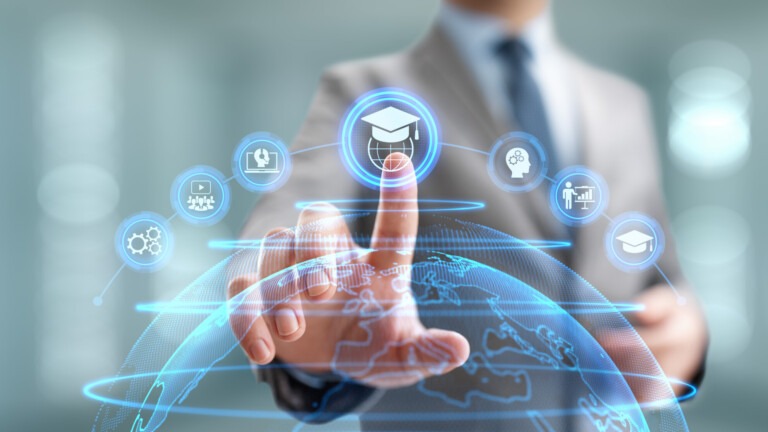How To Incorporate IoT in Education

From agricultural endeavors to construction sites, the Internet of Things now touches every facet of modern life – and with the growing presence of IoT in education, that influence may be seen for generations to come.
A recent report from Verified Market Research estimated that the IoT in education market could reach a valuation of $26.8 billion USD by 2028 with a CAGR of 20.06%. These findings are similar to a separate report from Emergen Research that suggests the IoT in education market would reach a valuation of $25.42 billion within the same time frame.
It’s clear, then, that there is a lot of promise for IoT in the education market, but how exactly does one fit IoT into the education world?
IoT in Education
Whether it’s a K-12 environment or a collegiate workshop, there are myriad potential uses for IoT devices in an educational setting. This can be largely separated into two separate concepts: tools that help the educational process, and those that improve the learning environment.
Devices in the former category are built off actionable data. Tracking the performance statistics of students and using AI to analyze the data can allow educators to better address their pupils’ individual challenges and strengths, and tailor lessons better.
Devices that in the latter category, meanwhile, are using IoT to improve the classroom experience in several ways. Things like programmable connected LED lighting replacing oppressive fluorescent lighting to help improve students’ mood and energy levels, or smart locks and security cameras that provide renewed security for learners in public schools.
There is any number of unique devices finding their way into the modern classroom. Here are just a few of the technologies that are improving the way students learn:
- Digital Whiteboards: Sometimes called “smartboards,” digital whiteboards are interactive displays that grant instructors and students unprecedented access to the internet. These devices can serve as hubs for students and teachers to collaborate on the same document, share content across multiple devices, store notes and documentation from classroom discussions, and more.
- Document Cameras: A promising solution for remote learning, document cameras allow instructors to wirelessly broadcast their laptop, tablet, or smartphone screens to students. These cameras let teachers record lessons, interact with documents live in full view of students, and engage with any questions remotely.
- Virtual/Augmented Reality: Utilizing specialized VR/AR headsets, teachers can craft immersive lessons that allow students to experience historical or hypothetical concepts in a more intimate fashion. This technology is also proving popular as a solution for workplace training, as it can allow employees to learn more about products that may not yet be in stock or handle complex machinery that may not be safely managed otherwise (i.e. aircraft).
Other IoT solutions carving a place in the education sector include smart thermostats to regulate classroom temperature, smart sensors and cards to track in-person attendance, and asset tracking that allows schools to track any devices they may make available to students.

Challenges to Adoption
Of course, introducing IoT in education is a complex undertaking. The trials that the education system faces in light of the ongoing Covid-19 pandemic, for example, have tested the digital divide in households across the globe. Many low-income households face challenges with inadequate internet access for IoT devices.
Even in the ideal settings, remote education – even with the added advantage of smart devices – is a discipline that is still finding its feet. NWEA research suggests that remote students in 3-8 grades only attain about 70% of the reading gains and 50% of the math gains of more traditional learning environments.
The Benefits of IoT in Education
IoT devices have the potential to help learners of all shapes and sizes. Students in a collegiate or workplace environment can utilize these tools to learn more efficiently and securely. The remote access granted by IoT devices also helps to facilitate remote and distance learning, which has become an essential part of the modern education landscape.
The International Society for Technology in Education (ISTE) claims that as many as two-thirds of modern students will eventually rely on technologies that have not yet been invented by the time they enter the job market. As such, introducing students to emerging technologies at an early age may make them more comfortable with the advancements yet to come and improve their ability to function in technical environments.
Some other benefits that can stem from early exposure to IoT technologies include:
- Multitasking: Studies suggest that early exposure to technologies could improve a child’s ability to multitask. This is an invaluable life skill.
- Spatial relations: A Temple University study found that children who interacted with visual technologies like video games develop improved spatial skills over their peers, granting them an advantage with skills such as following written directions or reading a map.
- Problem-solving/decision making: Learning new and complex technologies at an early age allows students to practice decision-making and problem-solving skills in an educational setting. This practice can help students recognize patterns more easily and gain confidence in their decision-making process, something that will make them more effective in the workplace whenever they come of age.
IoT devices also let educators create more unique and creative learning environments that emphasize interactivity and approachability. This helps to redefine the teacher’s role from instructor to facilitator, as their task becomes more about helping students find the solutions rather than drilling them in via repetition and memorization.
This can be particularly beneficial when dealing with special needs classes, as technologies such as text-to-speech aids can help address the unique challenges faced by these students.

A Continued Evolution
As the technologies themselves continue to mature and evolve, so too shall the role of IoT in education. Emerging disciplines such as AI could present untold benefits to the classroom via data analysis or through a complex digital assistant. Similarly, the continued advancement of IoT sensors could create a more secure comfortable environment for educators and students alike.
………………
Got a question for Soracom? Whether you’re an existing customer, interested in learning more about our product and services, or want to learn about our Partner program – we’d love to hear from you!



